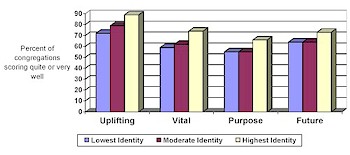A Quick Question
How strong is denominational identity?
The quick answer: Stronger than you might think.
The longer answer: Every day, or so it seems, another church drops its denominational identifier and changes its name to Community Church, Covenant Fellowship, or the Church of Somewhere. This often prompts pastors and scholars to ponder the declining importance of denominational ties for congregational identity. Research conducted by Faith Communities Today (FACT) provides insights on the perceived strength of denominational identity and its effects on congregational life.
FACT data reveal that a surprisingly strong 62 percent of the 14,301 congregations studied claim to express their denominational heritage “quite well” or “very well.” Roughly the same percentage of congregations buy their worship materials “primarily” or “only” from their denomination. Congregations with distinct racial, ethnic or national identities affirm their denominational heritage even more strongly than others. Congregations that ranked highest on denominational heritage were also more likely to report excellent financial health.
This relatively rosy picture of the strength of denominational heritage is not shared uniformly by the 42 faith groups that participated in the FACT study. In broad strokes, congregations of historically black or highly sectarian groups had the highest rate of denominational identification. Evangelical Protestant groups ranked next. Moderate and liberal Protestant congregations generally reported the lowest identification with a denominational tradition.
To test denominational identification as precisely as possible, FACT combined the denominational heritage question, with the congregation’s reported use of denominational materials and four questions of participation with other denominational congregations in joint worship, programs, social outreach, and ministerial associations. Focusing only on the Protestants, nearly a quarter (21 percent) of the FACT congregations ranked “very high” on this denominational identity scale with another 48 percent ranking “moderately high.” Only 31 percent fell into the “low” category.
Congregations with the highest denominational identity are most likely to describe themselves as preserving a strong racial/ethnic or national heritage. They are three times more likely than other congregations to view historic creeds, doctrines and traditions as a foundational source of religious authority. Those with the highest denominational identity are also least likely to have changed their style of worship in the past five years.
It should be no surprise that these denominationally strong congregations are heavily populated with “cradle” members. A full two thirds of congregations in the strongest identity category reported that more than 40 percent of their adherents were lifelong members of the denomination. Conversely, in those congregations with higher percentages of members who were new to the congregation, denominational identity was weaker.
What is somewhat surprising about those congregations highest in denominational identity are the ways their self-descriptions differed from those with lower identity factors. The denominationally strong congregations more often described their worship as “uplifting” or “inspirational”. They saw their congregation as being “vital and alive” with a clear sense of mission and purpose. They also were more likely to be excited about the future of the congregation (see figure 1).
Figure 1: Identity and Vitality: Ties appear to help
Percent of congregations rating each characteristic as describing themselves very or quite well

It is important to note, however, that denominational identity is not a guaranteed formula for church growth. The larger the congregation in terms of total adherents or regularly participating adult members, the weaker the denominational identity. In addition, the FACT data showed no relationship between percentage of growth in the past five years and denominational identity.
The negative relationship between size and denominational identity raises an interesting nuance within mainline churches. Two Protestant groups, the Evangelical Lutheran Church in America and the Episcopal Church, stood out in the FACT study as having significantly higher identification with their respective denominations than the other mainline churches. This created a distinctive dynamic within the congregations of these two denominations. Those ELCA and Episcopal congregations that had strong ties to their denominations were much more likely to be larger in membership and they also were more heavily populated with persons who had joined in the past five years.
It may be true that denominational identity has less salience for congregations generally. However, the FACT information clearly shows that there are significant positive implications for a church to embrace its denominational identity in a robust manner. Denominational identity still makes a difference. And if this identity is strongly held, it makes a positive difference.
For more information on denominations, visit the section of our site dedicated to this topic.
Return to the Quick Question archive
|
